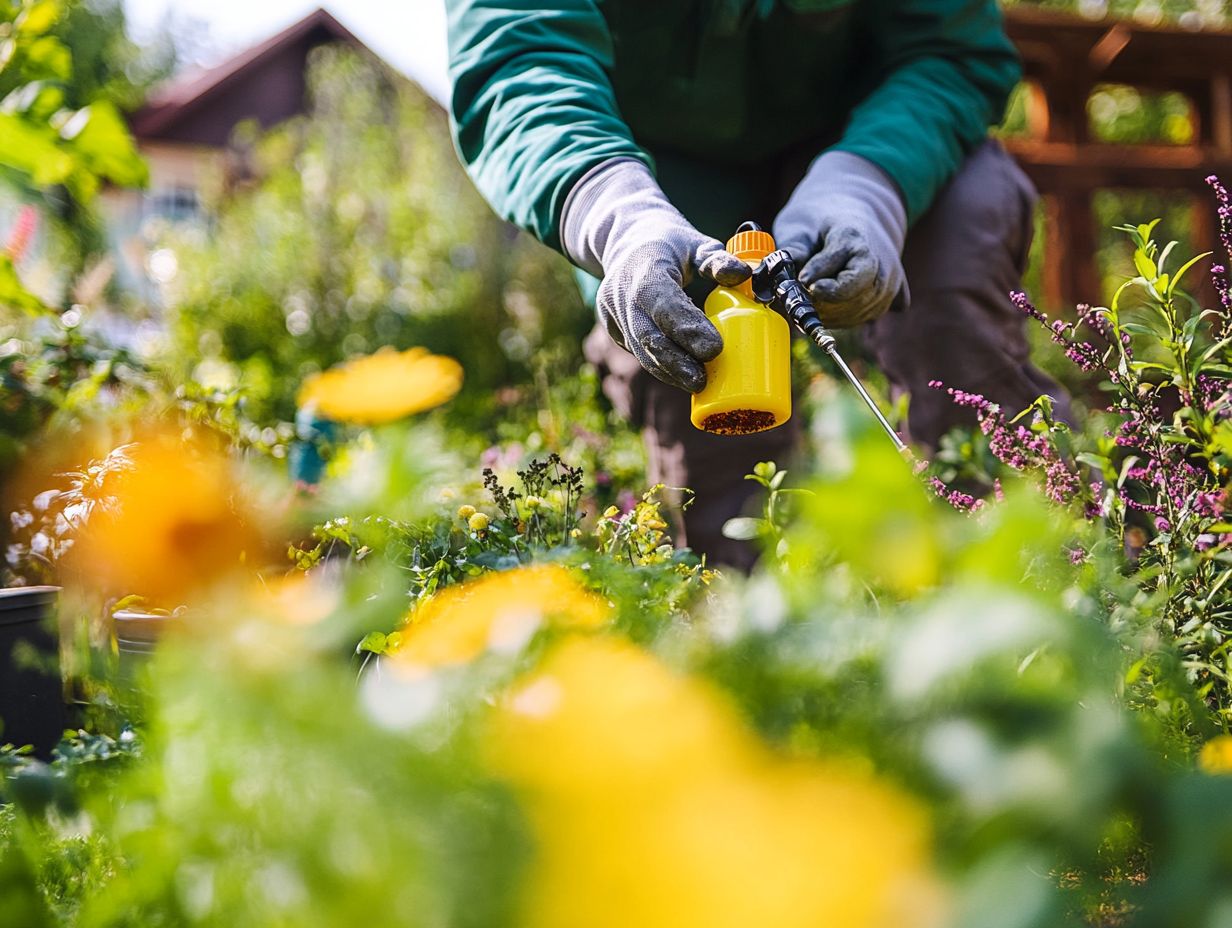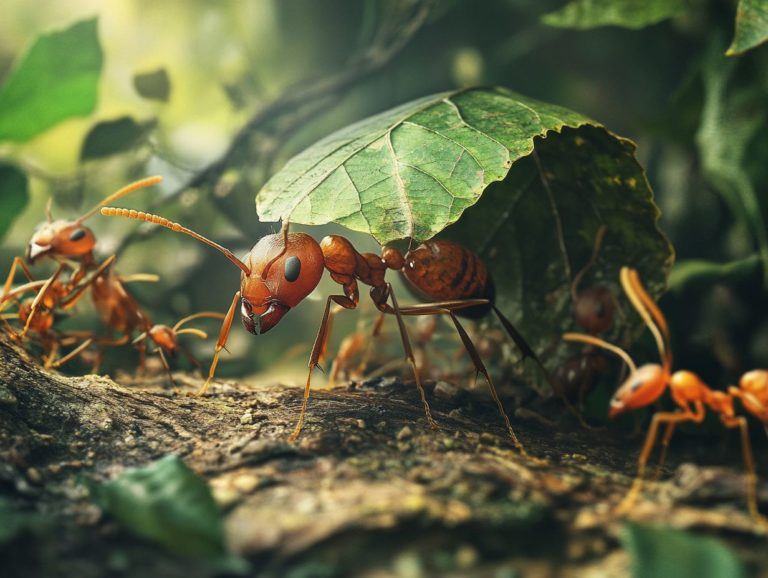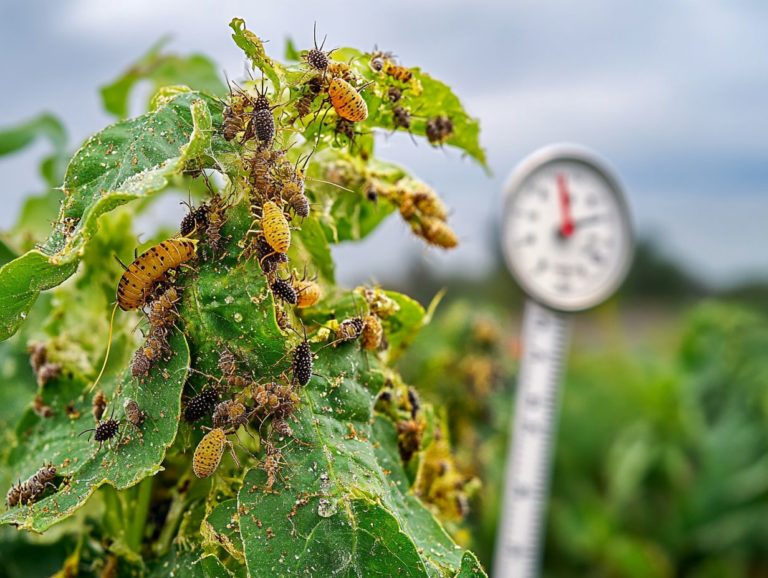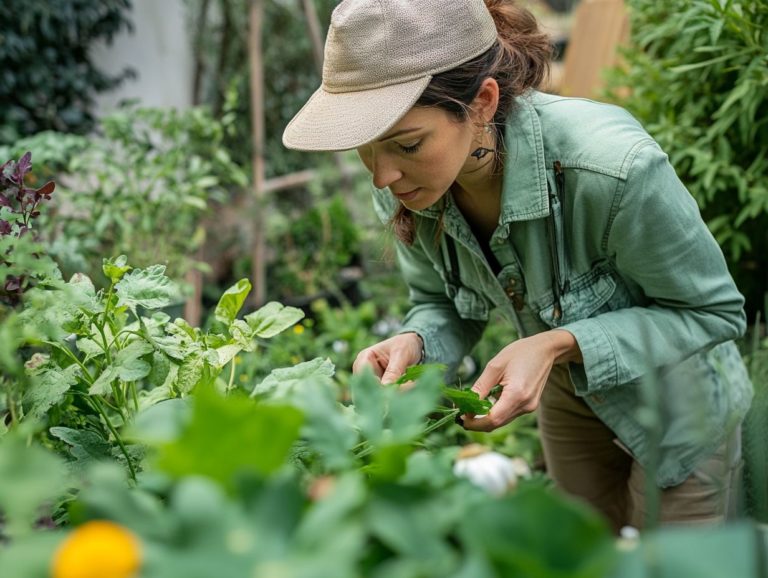5 Eco-Friendly Pest Control Practices
In a world that s becoming ever more aware of its environmental footprint, eco-friendly pest control practices are emerging as effective and sustainable alternatives to traditional methods.
This article delves into five natural strategies for managing pests:
- Employing natural repellents
- Attracting beneficial predators
- Setting up physical barriers
- Practicing proper waste management
- Utilizing organic pesticides
You ll learn about the advantages of these methods, how to identify eco-friendly services, and valuable tips for crafting a pest-resistant home.
Discover how you can safeguard your space while showing kindness to our planet!
Contents
- Key Takeaways:
- 1. Using Natural Repellents
- 2. Attracting Natural Predators
- 3. Implementing Physical Barriers
- 4. Proper Waste Management
- 5. Utilizing Organic Pesticides
- What Are the Benefits of Eco-Friendly Pest Control?
- How Can One Identify an Eco-Friendly Pest Control Service?
- What Are the Common Harmful Effects of Traditional Pest Control Methods?
- How Can One Encourage Others to Use Eco-Friendly Pest Control Practices?
- What Are the Most Common Eco-Friendly Pest Control Products?
- How Can One Make Their Home More Resistant to Pests Naturally?
- Frequently Asked Questions
- 1. What are 5 eco-friendly pest control practices?
- 2. Are natural repellents effective in pest control?
- 3. How does proper sanitation help in pest control?
- 4. What are physical barriers and how do they help in pest control?
- 5. How does crop rotation benefit pest control in agriculture?
- 6. Can natural predators be used for pest control?
Key Takeaways:

- Choose natural repellents, such as essential oils or plants, to deter pests without harmful chemicals.
- Attract natural predators, like birds or ladybugs, to control pest populations in an eco-friendly way.
- Using physical barriers, like screens or caulking, can prevent pests from entering your home without toxic pesticides.
1. Using Natural Repellents
Using natural repellents is essential if you’re looking to embrace eco-friendly pest control. Think of substances like essential oils, pest-repelling herbs, and microbial insecticides that offer effective solutions without the negative effects of traditional pesticides.
By opting for natural pest control methods, you not only shield your home from unwanted insects but also foster a healthier environment for beneficial insects and plants.
Let s look at some great options! The use of neem oil, diatomaceous earth, and insecticidal soaps each safe for the ecosystem while providing effective long-term pest removal can be particularly beneficial.
Consider incorporating essential oils like peppermint and lavender, which not only smell delightful but also help deter pesky visitors like mosquitoes and ants. Using vinegar as a cleaning agent is another smart move; it eliminates food residues that attract unwelcome guests.
These natural remedies can easily integrate into your pest management strategies, advocating for a mix of methods to achieve effective control.
Don t overlook the power of humane traps alongside these natural solutions. They allow you to capture pests without causing harm and align with a commitment to ethically treating wildlife, making your pest management both effective and compassionate.
2. Attracting Natural Predators
Attracting beneficial insects is a crucial aspect of effective pest management. These natural predators play a vital role in maintaining a balanced ecosystem and reducing pest populations without resorting to harmful pesticides.
Among these helpful allies, ladybugs and lacewings shine for their impressive ability to feast on aphids and other common garden nuisances.
By employing companion planting techniques like pairing vibrant flowers such as marigolds or aromatic herbs like dill with susceptible crops you can craft a welcoming habitat that draws in these beneficial insects.
Enhancing the environment with additional resources, such as water sources and shelter, ensures these predators not only visit but thrive in your garden. Such practices strengthen your organic pest management strategies and contribute to a healthier ecosystem, fostering biodiversity and promoting sustainable agriculture.
Start protecting your home today!
3. Implementing Physical Barriers
Implementing physical barriers is a highly effective strategy in eco-friendly pest control, providing you with a means to block unwanted pests like insects and rodents while minimizing harm to the environment and beneficial species.
You can employ various types of physical barriers to create a strong protection against pests. For instance, consider draping nets over your gardens to shield delicate plants from flying insects. Row covers work wonders as protective shields for seedlings, ensuring they thrive without interference. Well-constructed fences can also deter larger intruders, such as rabbits and deer.
Don’t forget regular maintenance keeps your barriers strong and effective! Integrating humane traps allows for the safe relocation of captured rodents without inflicting harm. Make it a habit to check for tears in nets or ensure your fences remain secure.
By incorporating these barriers into a comprehensive pest management strategy, along with regular inspections and monitoring, you can achieve long-term success in maintaining both pest control and ecological balance!
4. Proper Waste Management

Proper waste management is an essential pillar of organic pest management. It not only keeps your surroundings tidy but also dramatically reduces the chances of attracting pests and rodents that thrive on available food sources.
By implementing practices such as composting organic waste, you can transform potential pest breeding grounds into valuable soil enhancers, fostering a healthier garden ecosystem. Secure garbage storage in bins with tight-fitting lids is crucial, as it prevents vermin from accessing refuse and effectively minimizes food sources for unwanted critters.
Establishing regular cleaning schedules further strengthens your efforts by removing debris and food remnants that could otherwise invite infestations. Incorporating these management techniques establishes a strong foundation for pest control while aligning seamlessly with natural pest control and integrated pest management, a combination of different methods to manage pests effectively.
This comprehensive approach creates a welcoming environment that’s beautifully pest-free.
5. Utilizing Organic Pesticides
Utilizing organic pesticides is essential to your eco-friendly pest control practices, presenting you with alternatives like microbial insecticides, neem oil, and insecticidal soaps. For those looking for more comprehensive strategies, consider the top 5 pest control techniques for vegetables. These options effectively combat pests while remaining safe for the environment.
These products feature active ingredients sourced from nature. For instance, microbial insecticides contain Bacillus thuringiensis, which specifically targets caterpillars, reducing their populations without endangering beneficial insects. Neem oil, derived from the seeds of the neem tree, disrupts the hormonal systems of various pests, making it particularly effective against aphids and spider mites. Similarly, insecticidal soaps work by suffocating soft-bodied insects such as whiteflies and mealybugs.
When applying these organic solutions, it s crucial to follow the usage guidelines meticulously. Ensure you cover the affected areas of your plants and avoid spraying during the hottest parts of the day. Employing safety measures like wearing gloves and steering clear of your eyes further enhances your protection.
By integrating these organic options into a comprehensive pest management strategy, you promote sustainable and effective pest control, striking a harmonious balance between harm reduction and ecological health.
What Are the Benefits of Eco-Friendly Pest Control?
The advantages of eco-friendly pest control go beyond mere pest removal. They encompass a commitment to environmental conservation and enhanced health for everyone nearby. Implementing 5 ways to encourage pollinators and control pests also nurtures biodiversity through natural pest management techniques instead of toxic pesticides.
By minimizing chemical exposure, you protect the immediate environment and safeguard the well-being of residents, especially vulnerable groups like children and pets.
When you employ strategies that promote beneficial insects, such as ladybugs and lacewings, you encourage a natural predator-prey balance. This effectively limits pest populations without resorting to synthetic chemicals.
Over time, these eco-friendly practices foster long-term sustainability. They allow your gardens and homes to flourish in harmony with nature. By embracing these methods, you cultivate healthier living environments that support diverse ecosystems, ultimately benefiting both the planet and your well-being.
How Can One Identify an Eco-Friendly Pest Control Service?
Identifying an eco-friendly pest control service means seeking out companies that emphasize natural pest control methods and adopt combined pest control methods. For those looking for effective strategies, checking out the top 10 tips for organic pest management ensures that effectiveness and environmental protection are integral to their approach.
As you search for trustworthy options, consider various criteria that reflect a commitment to sustainability. Certifications are a powerful indicator of a company s dedication to eco-friendly practices, so look for those recognized by reputable organizations.
Pay attention to the types of products used, such as nature-based chemicals, to ensure they align with your values regarding health and safety. Customer testimonials offer valuable insights into past successes and overall satisfaction, helping you pinpoint any potential red flags.
Talk openly with service providers to clarify their methods and see if they match your eco-friendly values.
What Are the Common Harmful Effects of Traditional Pest Control Methods?

Traditional pest control methods often lean heavily on harmful pesticides. These can pose serious health risks to you, your family, and your pets. They also wreak havoc on the environment, leading to the decline of beneficial insects and the contamination of soil and water sources.
Take neonicotinoids (a type of insecticide), for example. These widely used chemicals in agriculture have been linked to significant declines in bee populations, which are essential for pollination and food production. Similarly, glyphosate, commonly found in herbicides, has been associated with various health concerns, including cancer.
On the other hand, eco-friendly pest control practices like integrated pest management (IPM) and the use of natural predators present safer, more sustainable alternatives. For instance, implementing 5 simple ways to prevent pest infestations can protect human and animal health while promoting biodiversity and maintaining the delicate balance of ecosystems.
Embracing these safer alternatives isn’t just a choice; it’s an urgent necessity for the well-being of both nature and your community. Act now to protect your family and the environment!
How Can One Encourage Others to Use Eco-Friendly Pest Control Practices?
Encouraging you to embrace eco-friendly pest control practices involves a thoughtful blend of education, community engagement, and sharing successful prevention strategies, such as simple pest control hacks for gardeners, that showcase the benefits of natural methods.
One effective approach is to organize workshops. These are designed to inform you about sustainable techniques and empower you to implement these strategies in your own home. Enhance these interactive sessions with informational materials that clearly outline the advantages of eco-friendly options.
By leveraging social media platforms to share compelling imagery and success stories, you can help create a ripple effect. Inspire others to reconsider their conventional methods.
Personal testimonials are vital in this journey. When individuals share their positive experiences of transitioning to greener practices, it fosters a sense of community and motivates you and others to join the movement toward sustainability.
Join the eco-friendly movement today and make a difference!
What Are the Most Common Eco-Friendly Pest Control Products?
Some of the most effective eco-friendly pest control products you can consider include natural pesticides like neem oil, diatomaceous earth, and insecticidal soaps. Additionally, following 5 steps to reduce pest pressure in your garden offers a safe and efficient alternative to traditional chemical options.
These products are becoming increasingly popular among those who desire greener solutions without sacrificing effectiveness. Neem oil is well-known for disrupting the life cycle of pests, making it effective against a variety of insects. Diatomaceous earth acts as a physical barrier, dehydrating and eliminating pests upon contact. Insecticidal soaps work by suffocating insects, making them especially useful for managing soft-bodied pests like aphids and spider mites.
Using these eco-friendly products in your pest control plan can make a real difference! By incorporating them into a holistic pest management strategy, such as encouraging beneficial insects and adopting cultural practices, you can successfully control pest populations while promoting environmental health. Consider 5 reasons to choose organic pest management for even greater benefits.
How Can One Make Their Home More Resistant to Pests Naturally?
Enhancing your home s resistance to pests naturally requires a thoughtful blend of prevention strategies. Consider cleaning with vinegar, incorporating pest-repelling herbs, and practicing companion planting, which involves planting different crops together to deter pests naturally.
To cultivate a genuinely pest-free environment, focus on maintaining regular cleaning routines that eliminate food sources and minimize clutter. Sealing entry points, such as cracks and crevices in walls, windows, and doors, can significantly reduce the likelihood of unwelcome intrusions.
Encouraging biodiversity attracts pollinators and natural pest controllers to your garden. Planting marigolds or lavender can deter insects while adding a vibrant touch to your landscape. You might also consider installing barriers like copper mesh to block rodent access, further fortifying your home against pests.
Frequently Asked Questions

1. What are 5 eco-friendly pest control practices?
The 5 eco-friendly pest control practices include: using natural repellents, implementing proper sanitation, using physical barriers, practicing crop rotation, and attracting natural predators.
2. Are natural repellents effective in pest control?
Yes, natural repellents such as garlic, peppermint, and essential oils can effectively repel pests without using harmful chemicals.
3. How does proper sanitation help in pest control?
Proper sanitation helps eliminate access to food and water sources for pests, making your home or area less attractive to them.
4. What are physical barriers and how do they help in pest control?
Physical barriers, such as screens, netting, and caulking, can prevent pests from entering your home or garden, reducing the need for chemical pesticides.
5. How does crop rotation benefit pest control in agriculture?
Crop rotation helps reduce pest populations by interrupting their life cycles and making it difficult for them to establish in one area.
6. Can natural predators be used for pest control?
Yes, attracting natural predators such as birds, ladybugs, and praying mantises can help control pest populations without the use of chemicals.






